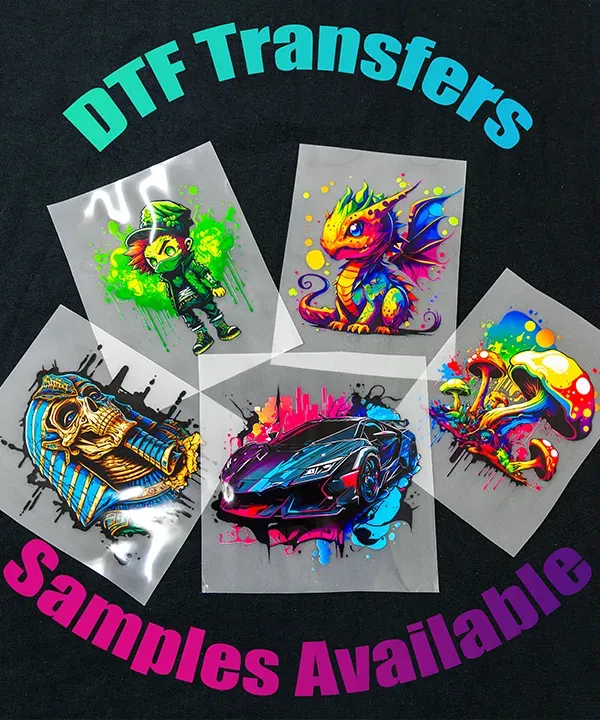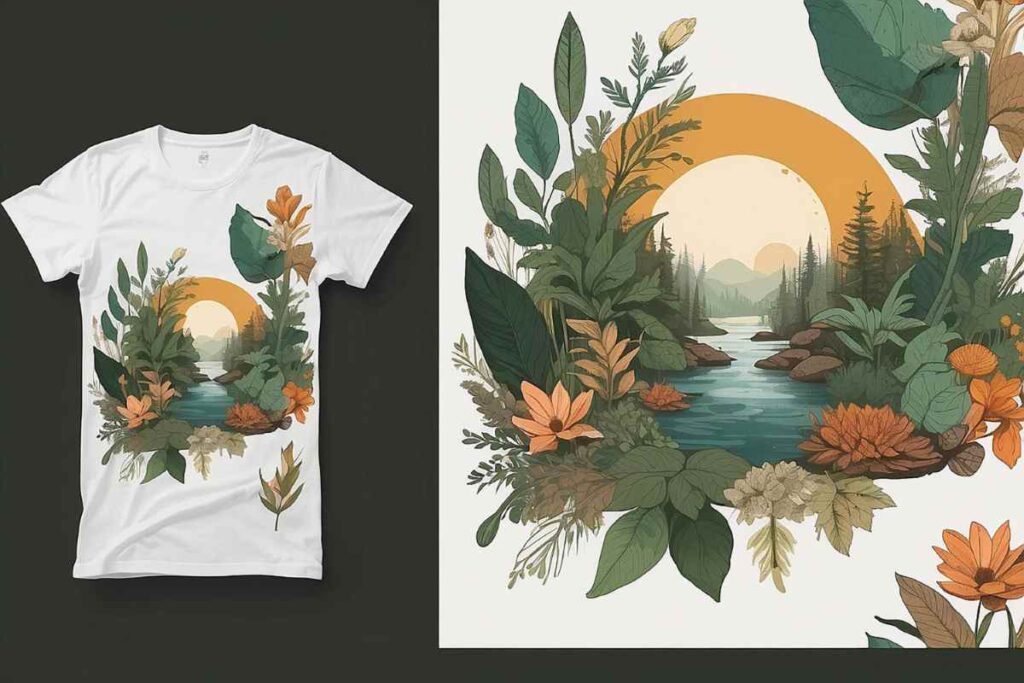DTF transfers, or Direct to Film transfers, are revolutionizing the world of fabric design by offering a cutting-edge method for custom fabric printing. Unlike traditional heat transfer methods, this technique captures vibrant colors and intricate details, making it perfect for everything from personalized t-shirts to bespoke textile creations. As we explore the DTF printing process, you’ll discover how this technology enhances the artistic possibilities for designers and small businesses alike. With its growing popularity, learning how to effectively utilize DTF transfers can elevate your projects, ensuring stunning results every time. Join us as we delve deeper into the multifaceted advantages of this innovative printing solution!
Often referred to as film-based printing, DTF transfers utilize a unique approach to apply high-quality designs onto various fabrics. This technique stands out from conventional methods due to its ability to deliver precise and vivid prints, making it ideal for artists and entrepreneurs who prioritize detail. Through advanced inkjet technology, this custom fabric printing method allows for creative freedom across multiple projects, ensuring each piece is a true reflection of personal style. As we dive into the mechanics of this process, we’ll highlight the versatility and cost-effectiveness that DTF printing brings to fabric design. Embrace the future of textile art with these groundbreaking heat transfer methods that are transforming the fabric printing landscape.
Understanding the DTF Printing Process
DTF transfers, or Direct to Film transfers, represent a revolutionary approach in the world of fabric printing. The process begins with printing a design onto a special film using high-quality inks that ensure maximum vibrancy and detail. This method allows even the most complex graphics to be flawlessly reproduced, making it an excellent choice for artists and businesses looking to create visually stunning custom fabric designs. Unlike traditional printing methods, which can be limited by setup costs and material compatibility, DTF provides flexibility that accommodates a wide variety of fabrics and design styles.
Once the design is printed onto the film, it undergoes a heat transfer application onto the chosen fabric. This heat transfer method ensures that the ink bonds correctly with the material, resulting in durable and long-lasting prints. The detailed application process, which typically involves setting precise temperatures and pressures, is crucial in achieving high-quality results. Understanding the DTF printing process can empower creators to leverage its benefits effectively, leading to impressive outcomes in various custom fabric projects.
Benefits of Using DTF Transfers for Fabric Design
One of the most significant advantages of using DTF transfers in fabric design is the unparalleled quality of prints produced. The DTF printing process excels in rendering vibrant colors, sharp details, and intricate designs that are often challenging to achieve with conventional printing methods such as screen printing. This quality is especially beneficial for businesses specializing in personalized apparel or niche markets where design precision is crucial.
Moreover, DTF transfers exhibit remarkable versatility; they can be applied to an extensive range of fabrics, including cotton, polyester, and blends. This adaptability makes them an optimal choice for a variety of projects—from creating tailored apparel to crafting unique promotional merchandise. The potential to work with different materials allows designers to explore innovative brand expressions and product offerings, making DTF an invaluable asset in custom fabric printing.
The Cost-Effectiveness of DTF Printing
For startups and small businesses, cost management is a key concern, especially when it comes to printing services. One of the standout features of DTF transfers is their cost-effectiveness, particularly for small production runs. Traditional printing techniques often require a minimum number of pieces to cover setup costs, which can be prohibitive for businesses that want to test designs or produce smaller quantities. In contrast, DTF transfers eliminate this barrier, allowing creators to print short runs without financial risk.
Additionally, the DTF printing process reduces material waste and enables designers to create unique products tailored to customer preferences. This flexibility not only enhances operational efficiency but also encourages creativity, allowing businesses to stay competitive in the ever-evolving landscape of custom fabric printing.
Recent Advancements in DTF Technology
As technology evolves, so does the quality and efficiency of DTF printing. Recent advancements have focused primarily on enhancing the adhesion properties and color vibrancy of the inks and films used in the DTF printing process. For example, newer printers equipped with advanced technology streamline the printing process and yield better output quality. This means that designers can produce vibrant designs with greater speed, ultimately meeting the demands of a fast-paced market for custom fabric printing.
Moreover, advancements in eco-friendly inks have also transformed the DTF landscape. Many suppliers now offer water-based options that reduce the environmental footprint associated with printing. This shift not only appeals to eco-conscious consumers but also aligns with broader industry trends aimed at sustainability. By adopting these innovations, businesses can enhance their product offerings while promoting responsible practices.
Preparing Designs for DTF Transfers
To achieve optimal results with DTF transfers, proper design preparation is essential. High-resolution vector files are recommended because they preserve clarity and maintain detail throughout the transfer process. A well-structured design file will enable the vibrant colors and intricate patterns typical of DTF printing to shine through, leading to high-quality fabric outcomes. Additionally, understanding how different fabric types may affect color and design visibility is crucial for ensuring the best results.
It’s also important to choose colors that contrast well with your fabric choice, as this ensures that the designs will pop. Adequate preparation of your designs will not only enhance your printed products but also streamline the overall production process, making it easier to replicate successful designs consistently.
Maximizing Results with Heat Transfer Settings
The key to successful DTF transfers lies in precision during the heat transfer stage. Correctly setting the heat press temperature and pressure is crucial for ensuring that the design adheres well to the fabric. Manufacturers typically recommend a temperature range of 300°F to 320°F (around 150°C to 160°C) and a pressing time of 10-15 seconds. It’s vital for users to follow these guidelines closely, as improper settings can lead to unsatisfactory results such as peeling or fading designs.
Furthermore, utilizing a heat press that provides even and consistent pressure will significantly enhance the durability of your prints. Beginners should consider conducting tests to determine the ideal settings for different fabric types, ensuring that every transfer is optimally applied for the best possible finish.
Frequently Asked Questions
What is the DTF printing process and how does it work?
DTF transfers, or Direct to Film transfers, involve printing a design onto a special film that is then heat pressed onto fabric. This method allows for intricate details and vibrant colors to be transferred to various materials, making it ideal for custom fabric printing.
What are the advantages of using DTF transfers for fabric design?
The primary advantages of DTF transfers include high print quality, versatility in fabric applications, and cost-effectiveness for small runs. Unlike traditional screen printing, DTF can reproduce detailed designs on a wide range of fabric types, including cotton and polyester.
How can I prepare my design for DTF printing effectively?
To prepare your design for DTF printing, use high-quality vector files to maintain clarity. Ensure the design is optimized for fabric, considering color contrast and placement. Proper preparation is crucial for a successful heat transfer process.
What materials do I need for successful DTF transfers?
For successful DTF transfers, you’ll need high-quality DTF inks and films. Brands like Epson offer specialized inks that enhance color vibrancy and durability, ensuring the best results for your custom fabric printing projects.
What temperature and pressure settings are recommended for DTF heat transfer methods?
Recommended heat press settings for DTF transfers are typically around 300°F to 320°F (150°C to 160°C) for 10-15 seconds. Proper calibration of your heat press is crucial to achieve optimal adhesion and quality in your fabric designs.
Are there eco-friendly options available for DTF printing?
Yes, recent advancements in DTF technology include eco-friendly water-based inks that are less harmful to the environment. This aligns with the growing demand for sustainable practices in the custom fabric printing industry.
| Key Points | Details |
|---|---|
| What are DTF Transfers? | A technique where designs are printed on a special film and then transferred to fabric using heat, allowing for vibrant and detailed prints. |
| Key Advantages | 1. Quality and Detail: Produces high-definition prints with intricate designs. 2. Versatility: Can be applied to various fabrics like cotton, polyester, and blends. 3. Cost-Effective: Ideal for small runs, allowing economical production of custom orders. |
| Recent Developments | Improved technology from manufacturers like Epson enhances print quality, quicker production, and eco-friendly water-based inks are now available. |
| How to Use DTF Transfers | 1. Design Preparation: Use high-quality vector files. 2. Correct Ink and Film Selection: Choose high-quality materials for vibrant prints. 3. Heat Press Settings: Optimal temperature is 300°F to 320°F for 10-15 seconds. 4. Post-Press Handling: Allow cooling before peeling for best adhesion. |
Summary
DTF Transfers are revolutionizing the way designs are applied to fabric, merging stunning detail with cost-effectiveness and flexibility. This innovative printing method stands out due to its ability to deliver vibrant colors and intricate designs that traditional printing methods often miss. Whether you’re an artist, a small business owner, or a DIY enthusiast, DTF transfers provide an easy and effective means to create personalized fabric items. Embracing DTF transfers opens up endless possibilities for unique apparel and creative fabric projects, ensuring that your designs not only stand out but also last.


